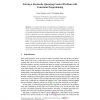390 search results - page 50 / 78 » Hybrid Control as a Method for Robot Motion Programming |
ICRA
1998
IEEE
14 years 21 days ago
1998
IEEE
A new method of handling the kinematic singularities of serial robotic manipulators is proposed. The idea is to transform the manipulator's workspace W into a desingularized ...
UAI
2004
13 years 9 months ago
2004
Although many real-world stochastic planning problems are more naturally formulated by hybrid models with both discrete and continuous variables, current state-of-the-art methods ...
CPAIOR
2007
Springer
14 years 2 months ago
2007
Springer
In a facility with front room and back room operations, it is useful to switch workers between the rooms in order to cope with changing customer demand. Assuming stochastic custome...
IJCAI
2007
13 years 10 months ago
2007
Programming a humanoid robot to walk is a challenging problem in robotics. Traditional approaches rely heavily on prior knowledge of the robot's physical parameters to devise...
ICRA
2002
IEEE
14 years 1 months ago
2002
IEEE
Visual Servoing has been a viable method of robot manipulator control for more than a decade. Image-Based Visual Servoing (IBVS), in particular, has seen considerable development ...

